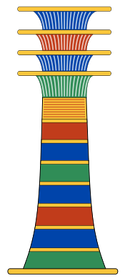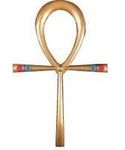Vital Reflections
1) In the poem “Djed Pillar”, what is the author referring to in her descriptors? What is a Djed Pillar? What does a Ankh mean? In this poem, does the author allow for her readers & listeners to define/interpret the poem for themselves or does she want her readers to view this poem how it represents her?
The descriptors in the poem Djed Pillar describes and represent God (The Creator), and how God (the Creator) is our everything. God is everywhere and God is within us all.
 A Djed Pillar is a pillar-like ancient Kemetic (Egyptian) symbol representing stability, enduring, and strength. A Djed Pillar is a column with 4 parallel lines crossing the upper portion of the column. A Djed Pillar looks similar to a backbone or vertebrae.
A Djed Pillar is a pillar-like ancient Kemetic (Egyptian) symbol representing stability, enduring, and strength. A Djed Pillar is a column with 4 parallel lines crossing the upper portion of the column. A Djed Pillar looks similar to a backbone or vertebrae.
 "The Ankh is defined as: The symbolic representation of both Physical and Eternal life." An Ankh also symbolizes the union of male and female principles in the origins of life; The Ankh is " a powerful symbol that was first created by Africans in Ancient Egypt." http://www.crystalinks.com/ankh.html
"The Ankh is defined as: The symbolic representation of both Physical and Eternal life." An Ankh also symbolizes the union of male and female principles in the origins of life; The Ankh is " a powerful symbol that was first created by Africans in Ancient Egypt." http://www.crystalinks.com/ankh.html
"The Ankh is commonly known to mean 'life' in the language of Ancient Kemet (land of the Blacks) renamed Egypt by the Greeks. It is also a symbol for the power to give and sustain life." http://www.crystalinks.com/ankh.html
Yes, Readers may interpret the poem Djed Pillar how he or she see fit. It could stand for a man for his woman, a woman for her man, a patriarch or matriarch of a family. However, to the author,, the poem Djed Pillar is God (the Creator) in every aspect of life.
2) In “Cry For Me” where is Kemet? What is another name for Kemet? In the process for one to Know Thyself, one must start at the beginning. On this Earth, where is the beginning source of humankind? Do you as the reader feel in any way connected to that beginning source? Why or why not?
Kemet is located on the continent of Alkebu-Lan "Land of the Spirited People" also known as Africa. Specifically, Kemet is geographically located in the Northern regions of Alkebu-Lan (Africa). Kemet (KMT) is the original name for Egypt. The beginning source of humankind is on the continent of Alkebu-Lan (Africa).
An individual has to ask his or herself if he or she feels that connection to the "Land of the Spirited People".
3) What does Thema mean in the poem “Thema’s Evolution”? Does the word Thema have any spiritual ties to the author? Why does the author use the word transgressed after she uses the word transformed? How did Thema come in to fruition?
Thema means Queen, and was given to the author while she was on a field study in Kemet (Egypt). Thema mean Queen in both Egypt and Ghana.
(Pronounciation:TEH-mah Meaning: Queen Origin:Akan Country:Ghana Region:West Africa ....www.namesite.com) or (Pronounciation: THE-mah Meaning: Queen Ethnic Orgin: Egpyptian...www.mybirthcare.com)
When named Thema, the author immediately became Spiritually connected to the name which provide additional purpose to her journey in this life.
When in Kemet the author was transformed back to a state of awareness, and rekindled the her Spiritual connection. In turn, the author transgressed back to the reality of this world's current state. Realizing that the journey would be the path of getting to Know Thyself, but also realizing that the journey would be lonely because she began to see on a conscious level. Once you know, you are now accountable for what you know. Never just believe in something, know that you know through fact.
4) In “The Bering Strait” what is a Bering Strait? What is the Bering Strait a metaphor of? What type of message does the poem “The Bering Strait” provides?
"The Bering Strait, located just to the south of the Arctic Circle at the northern edges of the Bering Sea, is a somewhat narrow sea passage between the easternmost point of the Asian continent and the westernmost point of the North American continent.
This strait separates the United States and Russia by 58 miles (85 km), with a water depth that measures 100–165 feet, (30–50 meters). Archaeologists have concluded that during the last Ice Age, a natural land bridge still spanned the short distance between the two continents, which over eons of times has all but eroded due to the strong currents and relentless winds." (www.worldatlas.com)
5) In the poem, “This Honey” the author uses honey as a metaphor for what?
This Honey is a metaphor for all beautiful African Queens (all women of color). This Honey is a tribute to all women of color and all of her essence, whether in our past, present and future.
The descriptors in the poem Djed Pillar describes and represent God (The Creator), and how God (the Creator) is our everything. God is everywhere and God is within us all.
 A Djed Pillar is a pillar-like ancient Kemetic (Egyptian) symbol representing stability, enduring, and strength. A Djed Pillar is a column with 4 parallel lines crossing the upper portion of the column. A Djed Pillar looks similar to a backbone or vertebrae.
A Djed Pillar is a pillar-like ancient Kemetic (Egyptian) symbol representing stability, enduring, and strength. A Djed Pillar is a column with 4 parallel lines crossing the upper portion of the column. A Djed Pillar looks similar to a backbone or vertebrae.  "The Ankh is defined as: The symbolic representation of both Physical and Eternal life." An Ankh also symbolizes the union of male and female principles in the origins of life; The Ankh is " a powerful symbol that was first created by Africans in Ancient Egypt." http://www.crystalinks.com/ankh.html
"The Ankh is defined as: The symbolic representation of both Physical and Eternal life." An Ankh also symbolizes the union of male and female principles in the origins of life; The Ankh is " a powerful symbol that was first created by Africans in Ancient Egypt." http://www.crystalinks.com/ankh.html"The Ankh is commonly known to mean 'life' in the language of Ancient Kemet (land of the Blacks) renamed Egypt by the Greeks. It is also a symbol for the power to give and sustain life." http://www.crystalinks.com/ankh.html
Yes, Readers may interpret the poem Djed Pillar how he or she see fit. It could stand for a man for his woman, a woman for her man, a patriarch or matriarch of a family. However, to the author,, the poem Djed Pillar is God (the Creator) in every aspect of life.
2) In “Cry For Me” where is Kemet? What is another name for Kemet? In the process for one to Know Thyself, one must start at the beginning. On this Earth, where is the beginning source of humankind? Do you as the reader feel in any way connected to that beginning source? Why or why not?
Kemet is located on the continent of Alkebu-Lan "Land of the Spirited People" also known as Africa. Specifically, Kemet is geographically located in the Northern regions of Alkebu-Lan (Africa). Kemet (KMT) is the original name for Egypt. The beginning source of humankind is on the continent of Alkebu-Lan (Africa).
An individual has to ask his or herself if he or she feels that connection to the "Land of the Spirited People".
3) What does Thema mean in the poem “Thema’s Evolution”? Does the word Thema have any spiritual ties to the author? Why does the author use the word transgressed after she uses the word transformed? How did Thema come in to fruition?
Thema means Queen, and was given to the author while she was on a field study in Kemet (Egypt). Thema mean Queen in both Egypt and Ghana.
(Pronounciation:TEH-mah Meaning: Queen Origin:Akan Country:Ghana Region:West Africa ....www.namesite.com) or (Pronounciation: THE-mah Meaning: Queen Ethnic Orgin: Egpyptian...www.mybirthcare.com)
When named Thema, the author immediately became Spiritually connected to the name which provide additional purpose to her journey in this life.
When in Kemet the author was transformed back to a state of awareness, and rekindled the her Spiritual connection. In turn, the author transgressed back to the reality of this world's current state. Realizing that the journey would be the path of getting to Know Thyself, but also realizing that the journey would be lonely because she began to see on a conscious level. Once you know, you are now accountable for what you know. Never just believe in something, know that you know through fact.
4) In “The Bering Strait” what is a Bering Strait? What is the Bering Strait a metaphor of? What type of message does the poem “The Bering Strait” provides?
"The Bering Strait, located just to the south of the Arctic Circle at the northern edges of the Bering Sea, is a somewhat narrow sea passage between the easternmost point of the Asian continent and the westernmost point of the North American continent.
This strait separates the United States and Russia by 58 miles (85 km), with a water depth that measures 100–165 feet, (30–50 meters). Archaeologists have concluded that during the last Ice Age, a natural land bridge still spanned the short distance between the two continents, which over eons of times has all but eroded due to the strong currents and relentless winds." (www.worldatlas.com)
5) In the poem, “This Honey” the author uses honey as a metaphor for what?
This Honey is a metaphor for all beautiful African Queens (all women of color). This Honey is a tribute to all women of color and all of her essence, whether in our past, present and future.
